Ways to Increase Fruit and Vegetable Consumption
VerifiedAdded on 2023/02/01
|10
|2176
|52
AI Summary
This article provides tips and strategies to increase fruit and vegetable consumption for a healthier diet. It discusses the importance of meeting the recommended daily servings of fruits and vegetables and suggests ways to incorporate them into meals. The article also highlights the social determinants of health, such as educational attainment and income, and their impact on meeting dietary requirements.
Contribute Materials
Your contribution can guide someone’s learning journey. Share your
documents today.

Running head: DAILY FOOD & BEVERAGE DIARY 1
Daily Food & Beverage Diary
Name
Institution
Daily Food & Beverage Diary
Name
Institution
Secure Best Marks with AI Grader
Need help grading? Try our AI Grader for instant feedback on your assignments.
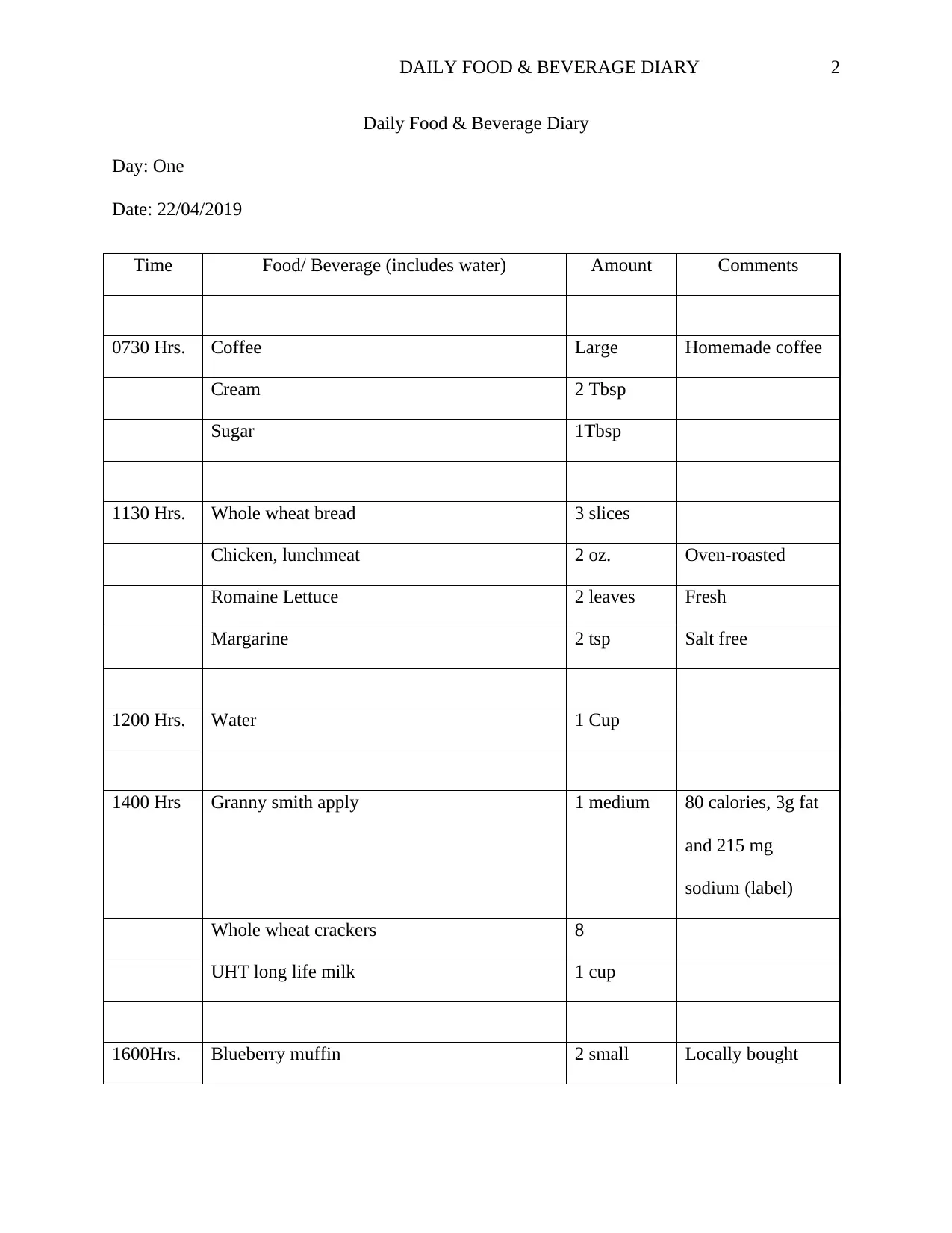
DAILY FOOD & BEVERAGE DIARY 2
Daily Food & Beverage Diary
Day: One
Date: 22/04/2019
Time Food/ Beverage (includes water) Amount Comments
0730 Hrs. Coffee Large Homemade coffee
Cream 2 Tbsp
Sugar 1Tbsp
1130 Hrs. Whole wheat bread 3 slices
Chicken, lunchmeat 2 oz. Oven-roasted
Romaine Lettuce 2 leaves Fresh
Margarine 2 tsp Salt free
1200 Hrs. Water 1 Cup
1400 Hrs Granny smith apply 1 medium 80 calories, 3g fat
and 215 mg
sodium (label)
Whole wheat crackers 8
UHT long life milk 1 cup
1600Hrs. Blueberry muffin 2 small Locally bought
Daily Food & Beverage Diary
Day: One
Date: 22/04/2019
Time Food/ Beverage (includes water) Amount Comments
0730 Hrs. Coffee Large Homemade coffee
Cream 2 Tbsp
Sugar 1Tbsp
1130 Hrs. Whole wheat bread 3 slices
Chicken, lunchmeat 2 oz. Oven-roasted
Romaine Lettuce 2 leaves Fresh
Margarine 2 tsp Salt free
1200 Hrs. Water 1 Cup
1400 Hrs Granny smith apply 1 medium 80 calories, 3g fat
and 215 mg
sodium (label)
Whole wheat crackers 8
UHT long life milk 1 cup
1600Hrs. Blueberry muffin 2 small Locally bought
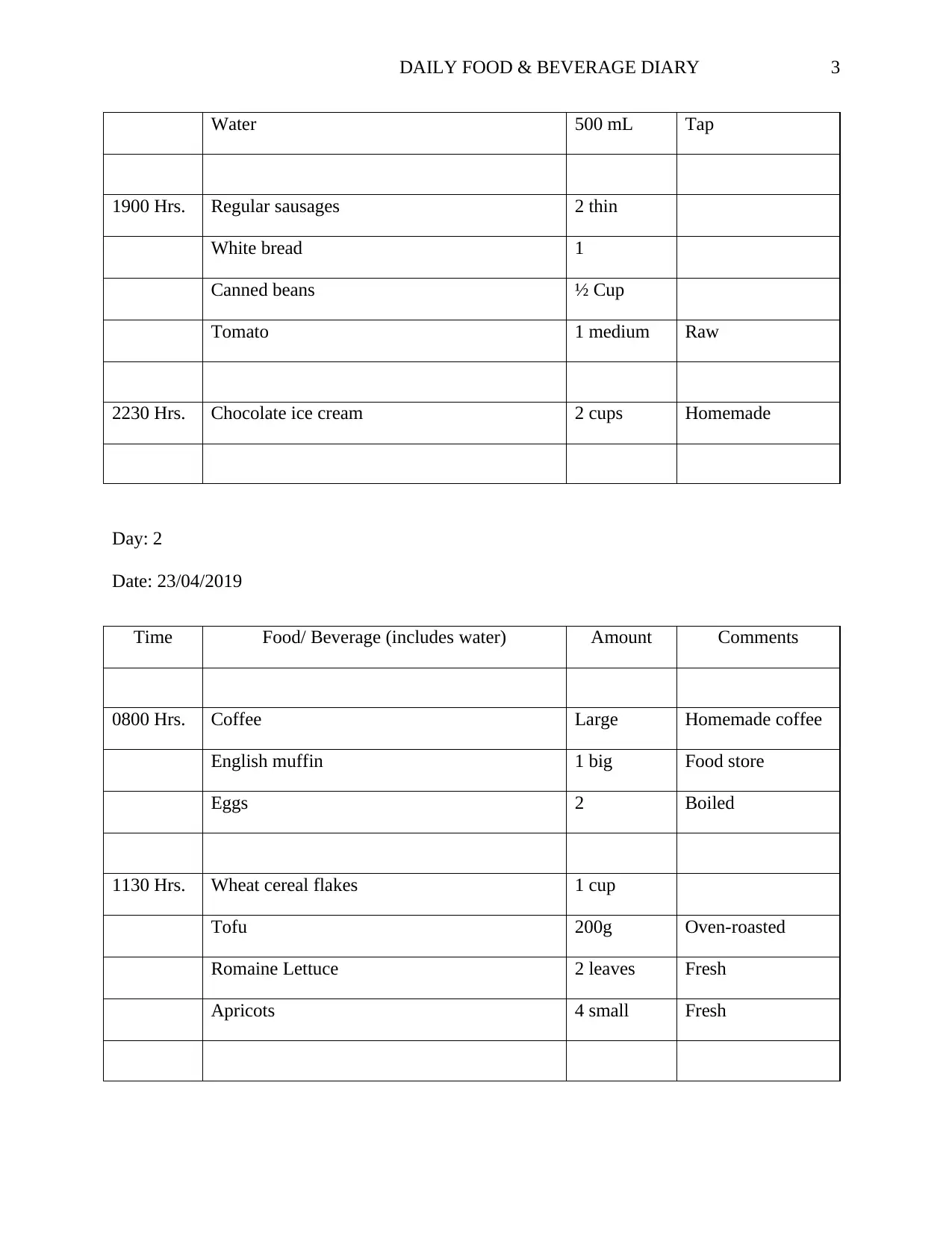
DAILY FOOD & BEVERAGE DIARY 3
Water 500 mL Tap
1900 Hrs. Regular sausages 2 thin
White bread 1
Canned beans ½ Cup
Tomato 1 medium Raw
2230 Hrs. Chocolate ice cream 2 cups Homemade
Day: 2
Date: 23/04/2019
Time Food/ Beverage (includes water) Amount Comments
0800 Hrs. Coffee Large Homemade coffee
English muffin 1 big Food store
Eggs 2 Boiled
1130 Hrs. Wheat cereal flakes 1 cup
Tofu 200g Oven-roasted
Romaine Lettuce 2 leaves Fresh
Apricots 4 small Fresh
Water 500 mL Tap
1900 Hrs. Regular sausages 2 thin
White bread 1
Canned beans ½ Cup
Tomato 1 medium Raw
2230 Hrs. Chocolate ice cream 2 cups Homemade
Day: 2
Date: 23/04/2019
Time Food/ Beverage (includes water) Amount Comments
0800 Hrs. Coffee Large Homemade coffee
English muffin 1 big Food store
Eggs 2 Boiled
1130 Hrs. Wheat cereal flakes 1 cup
Tofu 200g Oven-roasted
Romaine Lettuce 2 leaves Fresh
Apricots 4 small Fresh
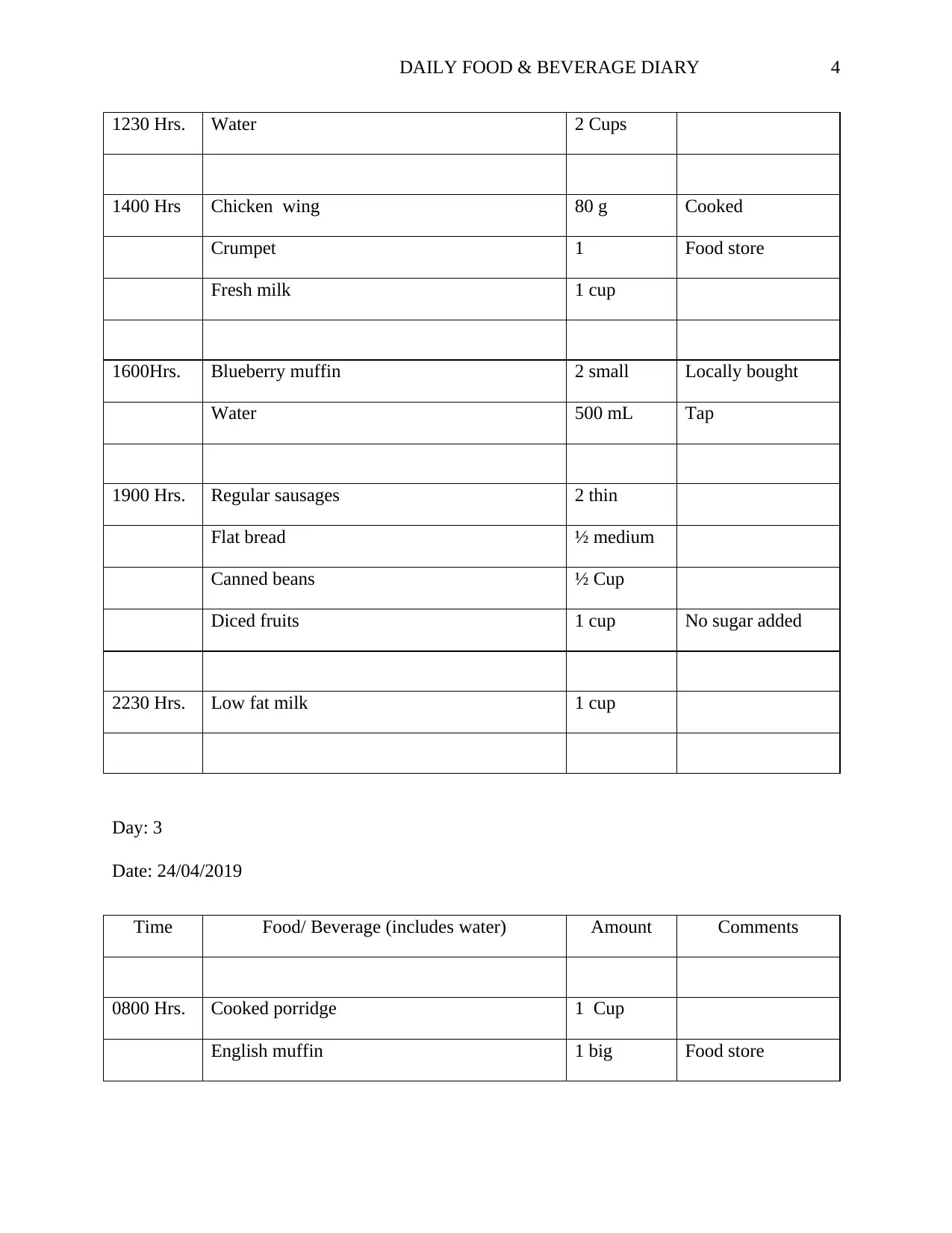
DAILY FOOD & BEVERAGE DIARY 4
1230 Hrs. Water 2 Cups
1400 Hrs Chicken wing 80 g Cooked
Crumpet 1 Food store
Fresh milk 1 cup
1600Hrs. Blueberry muffin 2 small Locally bought
Water 500 mL Tap
1900 Hrs. Regular sausages 2 thin
Flat bread ½ medium
Canned beans ½ Cup
Diced fruits 1 cup No sugar added
2230 Hrs. Low fat milk 1 cup
Day: 3
Date: 24/04/2019
Time Food/ Beverage (includes water) Amount Comments
0800 Hrs. Cooked porridge 1 Cup
English muffin 1 big Food store
1230 Hrs. Water 2 Cups
1400 Hrs Chicken wing 80 g Cooked
Crumpet 1 Food store
Fresh milk 1 cup
1600Hrs. Blueberry muffin 2 small Locally bought
Water 500 mL Tap
1900 Hrs. Regular sausages 2 thin
Flat bread ½ medium
Canned beans ½ Cup
Diced fruits 1 cup No sugar added
2230 Hrs. Low fat milk 1 cup
Day: 3
Date: 24/04/2019
Time Food/ Beverage (includes water) Amount Comments
0800 Hrs. Cooked porridge 1 Cup
English muffin 1 big Food store
Secure Best Marks with AI Grader
Need help grading? Try our AI Grader for instant feedback on your assignments.
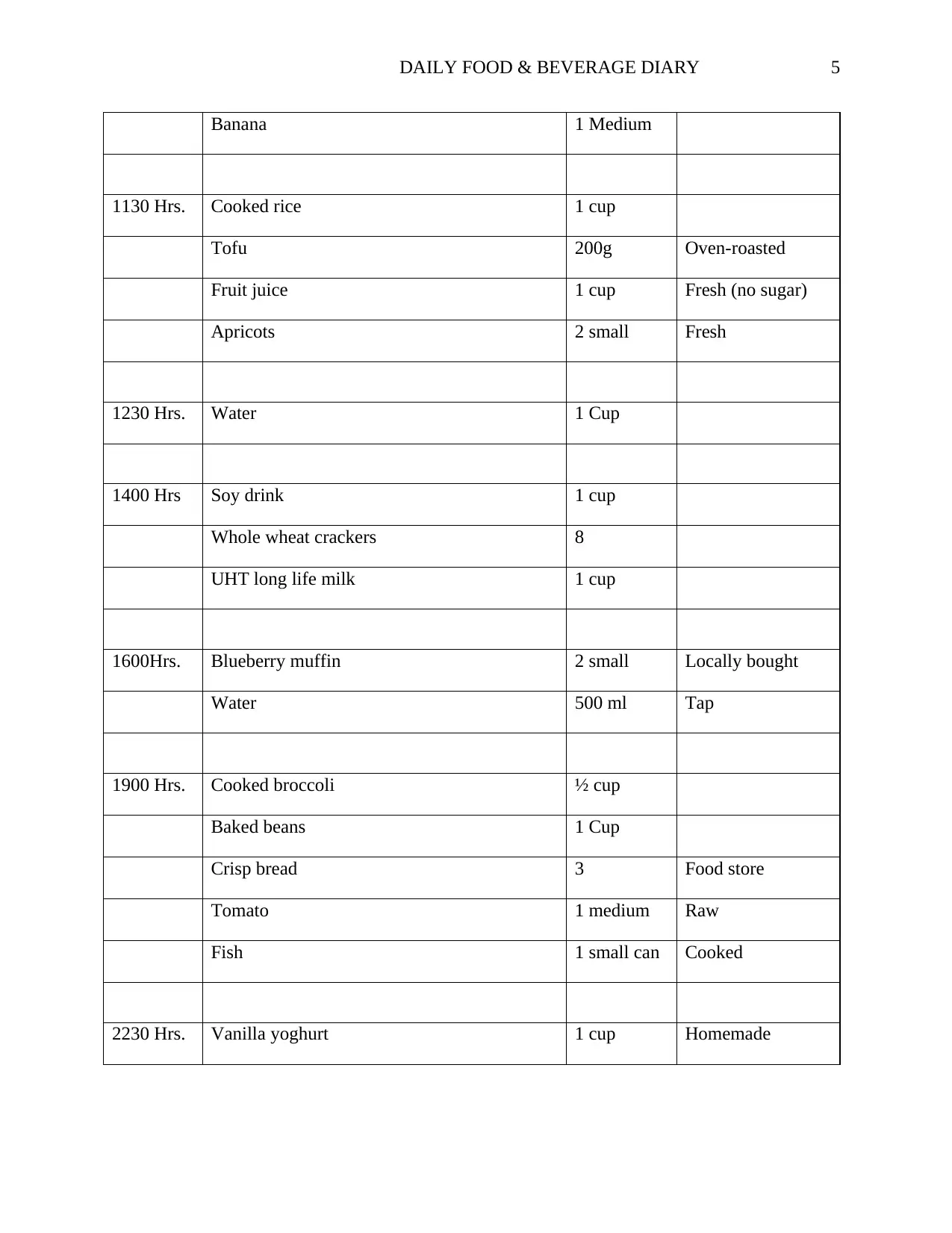
DAILY FOOD & BEVERAGE DIARY 5
Banana 1 Medium
1130 Hrs. Cooked rice 1 cup
Tofu 200g Oven-roasted
Fruit juice 1 cup Fresh (no sugar)
Apricots 2 small Fresh
1230 Hrs. Water 1 Cup
1400 Hrs Soy drink 1 cup
Whole wheat crackers 8
UHT long life milk 1 cup
1600Hrs. Blueberry muffin 2 small Locally bought
Water 500 ml Tap
1900 Hrs. Cooked broccoli ½ cup
Baked beans 1 Cup
Crisp bread 3 Food store
Tomato 1 medium Raw
Fish 1 small can Cooked
2230 Hrs. Vanilla yoghurt 1 cup Homemade
Banana 1 Medium
1130 Hrs. Cooked rice 1 cup
Tofu 200g Oven-roasted
Fruit juice 1 cup Fresh (no sugar)
Apricots 2 small Fresh
1230 Hrs. Water 1 Cup
1400 Hrs Soy drink 1 cup
Whole wheat crackers 8
UHT long life milk 1 cup
1600Hrs. Blueberry muffin 2 small Locally bought
Water 500 ml Tap
1900 Hrs. Cooked broccoli ½ cup
Baked beans 1 Cup
Crisp bread 3 Food store
Tomato 1 medium Raw
Fish 1 small can Cooked
2230 Hrs. Vanilla yoghurt 1 cup Homemade
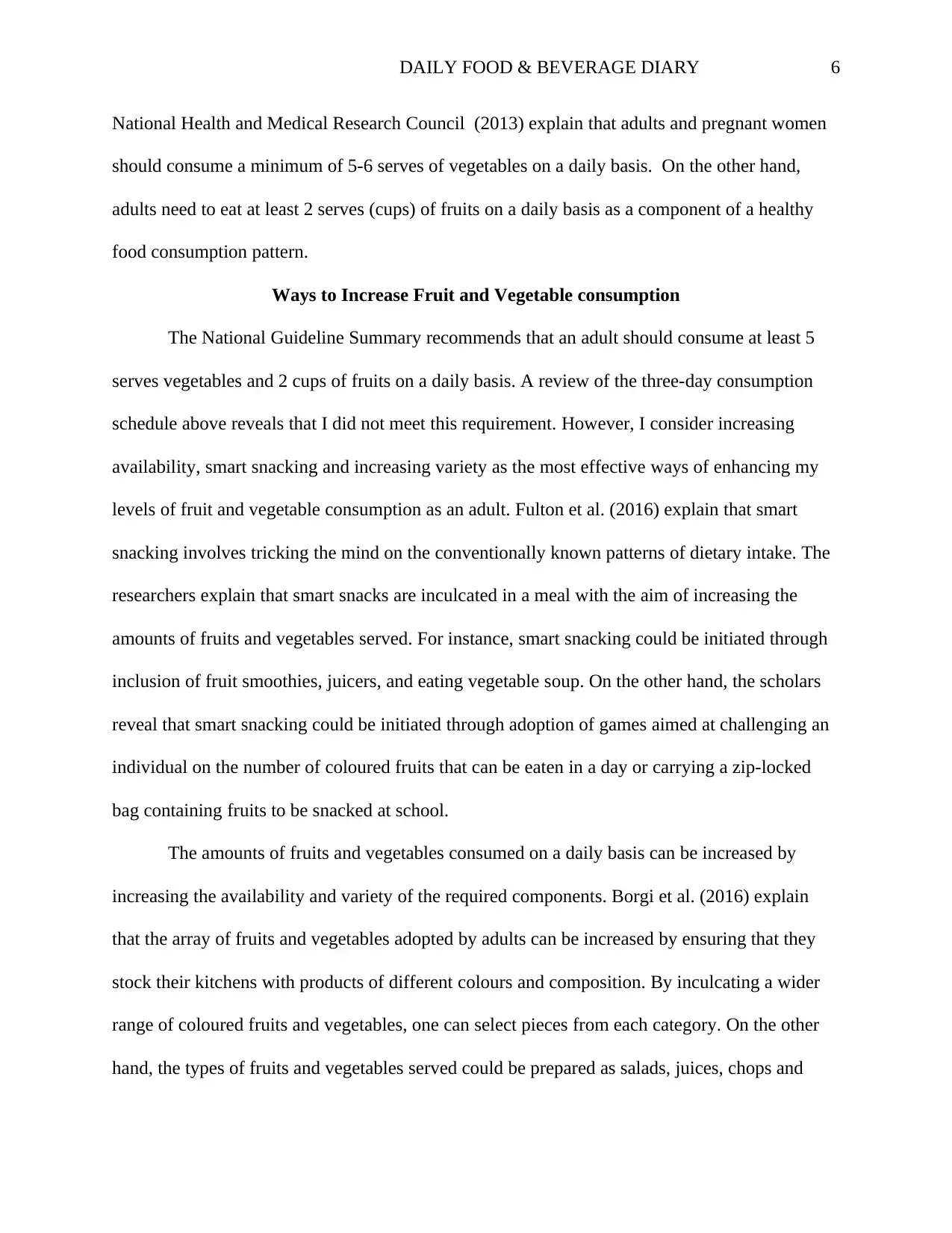
DAILY FOOD & BEVERAGE DIARY 6
National Health and Medical Research Council (2013) explain that adults and pregnant women
should consume a minimum of 5-6 serves of vegetables on a daily basis. On the other hand,
adults need to eat at least 2 serves (cups) of fruits on a daily basis as a component of a healthy
food consumption pattern.
Ways to Increase Fruit and Vegetable consumption
The National Guideline Summary recommends that an adult should consume at least 5
serves vegetables and 2 cups of fruits on a daily basis. A review of the three-day consumption
schedule above reveals that I did not meet this requirement. However, I consider increasing
availability, smart snacking and increasing variety as the most effective ways of enhancing my
levels of fruit and vegetable consumption as an adult. Fulton et al. (2016) explain that smart
snacking involves tricking the mind on the conventionally known patterns of dietary intake. The
researchers explain that smart snacks are inculcated in a meal with the aim of increasing the
amounts of fruits and vegetables served. For instance, smart snacking could be initiated through
inclusion of fruit smoothies, juicers, and eating vegetable soup. On the other hand, the scholars
reveal that smart snacking could be initiated through adoption of games aimed at challenging an
individual on the number of coloured fruits that can be eaten in a day or carrying a zip-locked
bag containing fruits to be snacked at school.
The amounts of fruits and vegetables consumed on a daily basis can be increased by
increasing the availability and variety of the required components. Borgi et al. (2016) explain
that the array of fruits and vegetables adopted by adults can be increased by ensuring that they
stock their kitchens with products of different colours and composition. By inculcating a wider
range of coloured fruits and vegetables, one can select pieces from each category. On the other
hand, the types of fruits and vegetables served could be prepared as salads, juices, chops and
National Health and Medical Research Council (2013) explain that adults and pregnant women
should consume a minimum of 5-6 serves of vegetables on a daily basis. On the other hand,
adults need to eat at least 2 serves (cups) of fruits on a daily basis as a component of a healthy
food consumption pattern.
Ways to Increase Fruit and Vegetable consumption
The National Guideline Summary recommends that an adult should consume at least 5
serves vegetables and 2 cups of fruits on a daily basis. A review of the three-day consumption
schedule above reveals that I did not meet this requirement. However, I consider increasing
availability, smart snacking and increasing variety as the most effective ways of enhancing my
levels of fruit and vegetable consumption as an adult. Fulton et al. (2016) explain that smart
snacking involves tricking the mind on the conventionally known patterns of dietary intake. The
researchers explain that smart snacks are inculcated in a meal with the aim of increasing the
amounts of fruits and vegetables served. For instance, smart snacking could be initiated through
inclusion of fruit smoothies, juicers, and eating vegetable soup. On the other hand, the scholars
reveal that smart snacking could be initiated through adoption of games aimed at challenging an
individual on the number of coloured fruits that can be eaten in a day or carrying a zip-locked
bag containing fruits to be snacked at school.
The amounts of fruits and vegetables consumed on a daily basis can be increased by
increasing the availability and variety of the required components. Borgi et al. (2016) explain
that the array of fruits and vegetables adopted by adults can be increased by ensuring that they
stock their kitchens with products of different colours and composition. By inculcating a wider
range of coloured fruits and vegetables, one can select pieces from each category. On the other
hand, the types of fruits and vegetables served could be prepared as salads, juices, chops and
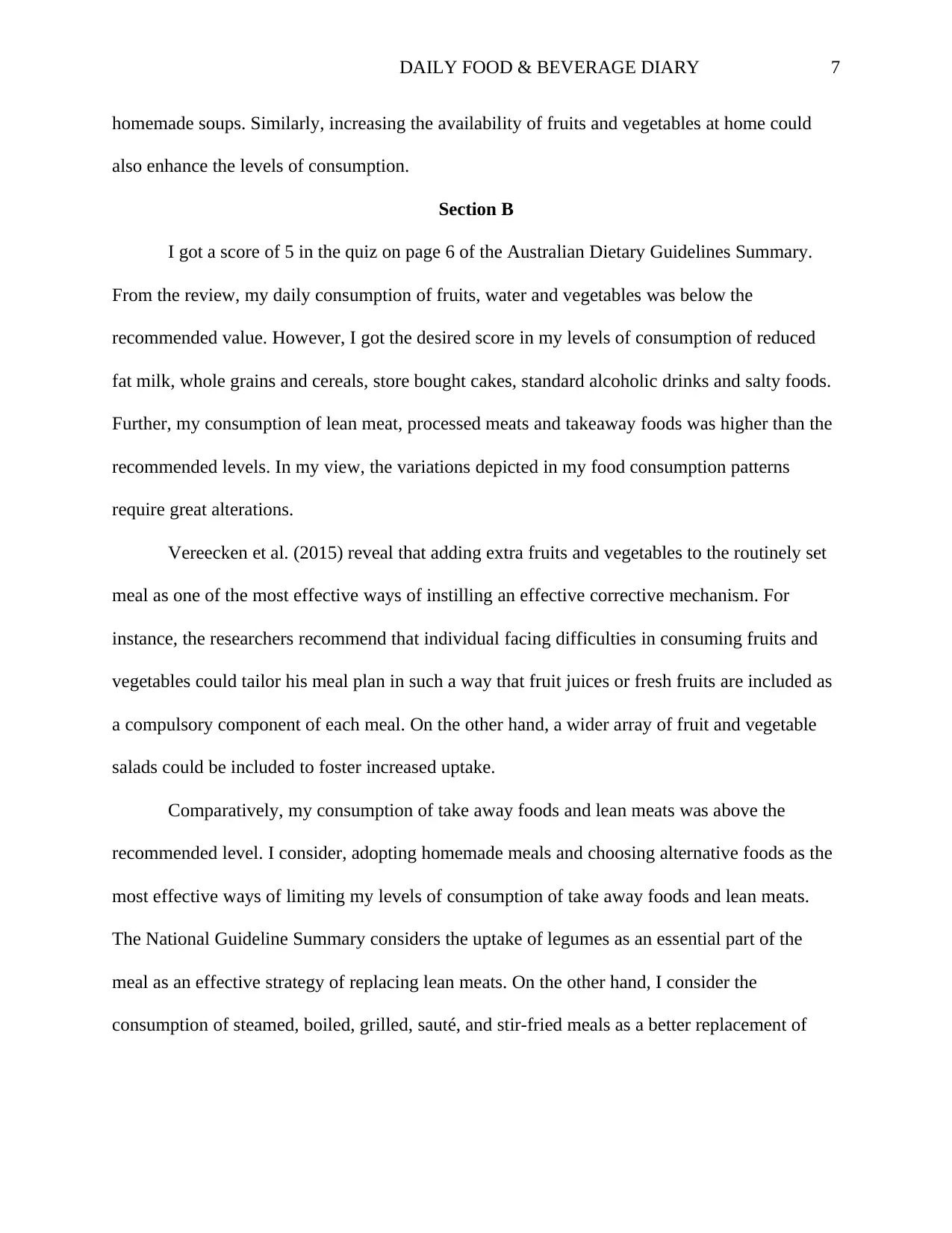
DAILY FOOD & BEVERAGE DIARY 7
homemade soups. Similarly, increasing the availability of fruits and vegetables at home could
also enhance the levels of consumption.
Section B
I got a score of 5 in the quiz on page 6 of the Australian Dietary Guidelines Summary.
From the review, my daily consumption of fruits, water and vegetables was below the
recommended value. However, I got the desired score in my levels of consumption of reduced
fat milk, whole grains and cereals, store bought cakes, standard alcoholic drinks and salty foods.
Further, my consumption of lean meat, processed meats and takeaway foods was higher than the
recommended levels. In my view, the variations depicted in my food consumption patterns
require great alterations.
Vereecken et al. (2015) reveal that adding extra fruits and vegetables to the routinely set
meal as one of the most effective ways of instilling an effective corrective mechanism. For
instance, the researchers recommend that individual facing difficulties in consuming fruits and
vegetables could tailor his meal plan in such a way that fruit juices or fresh fruits are included as
a compulsory component of each meal. On the other hand, a wider array of fruit and vegetable
salads could be included to foster increased uptake.
Comparatively, my consumption of take away foods and lean meats was above the
recommended level. I consider, adopting homemade meals and choosing alternative foods as the
most effective ways of limiting my levels of consumption of take away foods and lean meats.
The National Guideline Summary considers the uptake of legumes as an essential part of the
meal as an effective strategy of replacing lean meats. On the other hand, I consider the
consumption of steamed, boiled, grilled, sauté, and stir-fried meals as a better replacement of
homemade soups. Similarly, increasing the availability of fruits and vegetables at home could
also enhance the levels of consumption.
Section B
I got a score of 5 in the quiz on page 6 of the Australian Dietary Guidelines Summary.
From the review, my daily consumption of fruits, water and vegetables was below the
recommended value. However, I got the desired score in my levels of consumption of reduced
fat milk, whole grains and cereals, store bought cakes, standard alcoholic drinks and salty foods.
Further, my consumption of lean meat, processed meats and takeaway foods was higher than the
recommended levels. In my view, the variations depicted in my food consumption patterns
require great alterations.
Vereecken et al. (2015) reveal that adding extra fruits and vegetables to the routinely set
meal as one of the most effective ways of instilling an effective corrective mechanism. For
instance, the researchers recommend that individual facing difficulties in consuming fruits and
vegetables could tailor his meal plan in such a way that fruit juices or fresh fruits are included as
a compulsory component of each meal. On the other hand, a wider array of fruit and vegetable
salads could be included to foster increased uptake.
Comparatively, my consumption of take away foods and lean meats was above the
recommended level. I consider, adopting homemade meals and choosing alternative foods as the
most effective ways of limiting my levels of consumption of take away foods and lean meats.
The National Guideline Summary considers the uptake of legumes as an essential part of the
meal as an effective strategy of replacing lean meats. On the other hand, I consider the
consumption of steamed, boiled, grilled, sauté, and stir-fried meals as a better replacement of
Paraphrase This Document
Need a fresh take? Get an instant paraphrase of this document with our AI Paraphraser
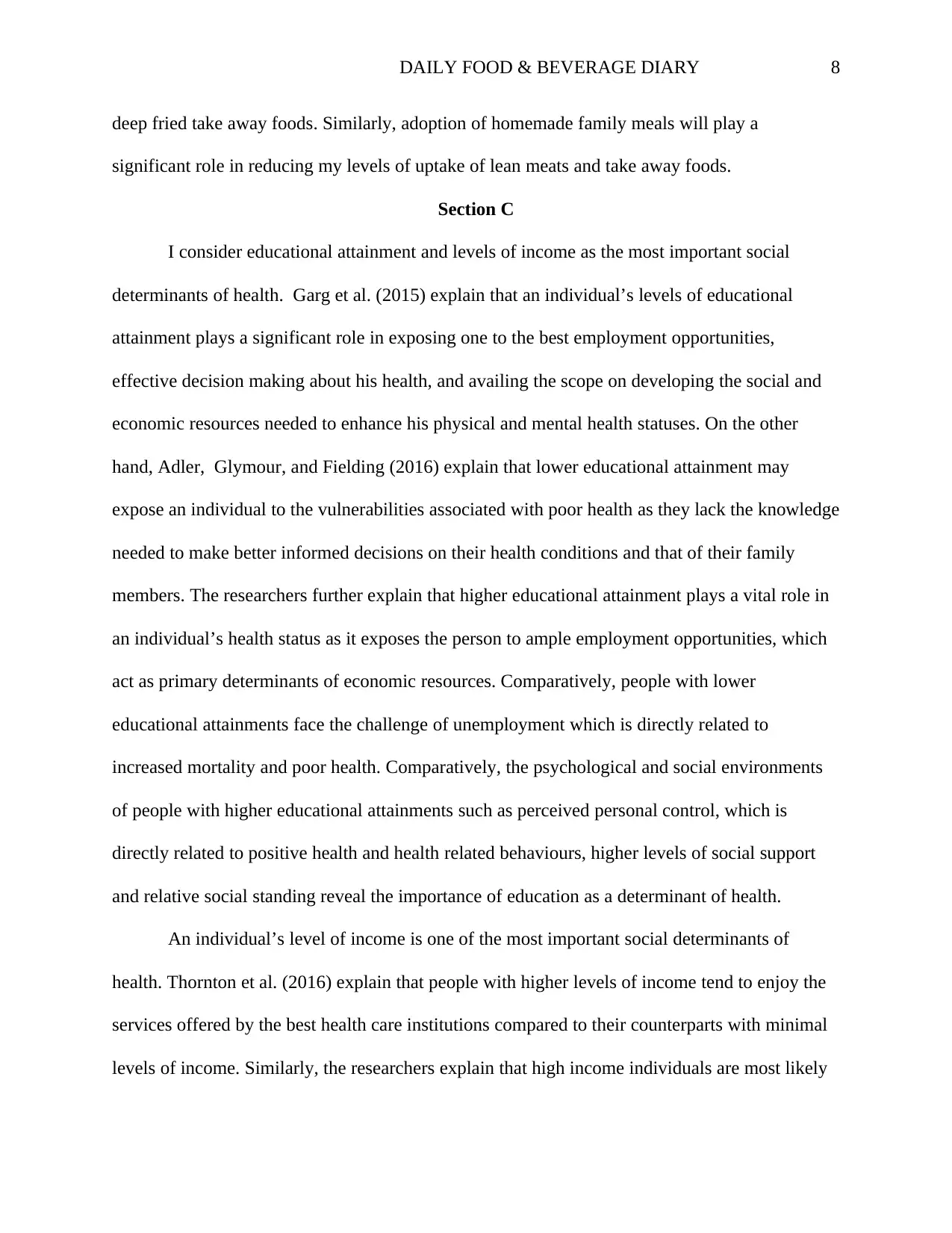
DAILY FOOD & BEVERAGE DIARY 8
deep fried take away foods. Similarly, adoption of homemade family meals will play a
significant role in reducing my levels of uptake of lean meats and take away foods.
Section C
I consider educational attainment and levels of income as the most important social
determinants of health. Garg et al. (2015) explain that an individual’s levels of educational
attainment plays a significant role in exposing one to the best employment opportunities,
effective decision making about his health, and availing the scope on developing the social and
economic resources needed to enhance his physical and mental health statuses. On the other
hand, Adler, Glymour, and Fielding (2016) explain that lower educational attainment may
expose an individual to the vulnerabilities associated with poor health as they lack the knowledge
needed to make better informed decisions on their health conditions and that of their family
members. The researchers further explain that higher educational attainment plays a vital role in
an individual’s health status as it exposes the person to ample employment opportunities, which
act as primary determinants of economic resources. Comparatively, people with lower
educational attainments face the challenge of unemployment which is directly related to
increased mortality and poor health. Comparatively, the psychological and social environments
of people with higher educational attainments such as perceived personal control, which is
directly related to positive health and health related behaviours, higher levels of social support
and relative social standing reveal the importance of education as a determinant of health.
An individual’s level of income is one of the most important social determinants of
health. Thornton et al. (2016) explain that people with higher levels of income tend to enjoy the
services offered by the best health care institutions compared to their counterparts with minimal
levels of income. Similarly, the researchers explain that high income individuals are most likely
deep fried take away foods. Similarly, adoption of homemade family meals will play a
significant role in reducing my levels of uptake of lean meats and take away foods.
Section C
I consider educational attainment and levels of income as the most important social
determinants of health. Garg et al. (2015) explain that an individual’s levels of educational
attainment plays a significant role in exposing one to the best employment opportunities,
effective decision making about his health, and availing the scope on developing the social and
economic resources needed to enhance his physical and mental health statuses. On the other
hand, Adler, Glymour, and Fielding (2016) explain that lower educational attainment may
expose an individual to the vulnerabilities associated with poor health as they lack the knowledge
needed to make better informed decisions on their health conditions and that of their family
members. The researchers further explain that higher educational attainment plays a vital role in
an individual’s health status as it exposes the person to ample employment opportunities, which
act as primary determinants of economic resources. Comparatively, people with lower
educational attainments face the challenge of unemployment which is directly related to
increased mortality and poor health. Comparatively, the psychological and social environments
of people with higher educational attainments such as perceived personal control, which is
directly related to positive health and health related behaviours, higher levels of social support
and relative social standing reveal the importance of education as a determinant of health.
An individual’s level of income is one of the most important social determinants of
health. Thornton et al. (2016) explain that people with higher levels of income tend to enjoy the
services offered by the best health care institutions compared to their counterparts with minimal
levels of income. Similarly, the researchers explain that high income individuals are most likely

DAILY FOOD & BEVERAGE DIARY 9
to acquire timely health care services compared to their low-income counterparts. Such premise
is based on the fact that high income individuals re exposed to the fiscal resources needed to
access high quality services offered in high standard institutions by qualified physicians.
Comparatively, the researchers explain that low-income individuals are most likely to suffer the
dangers associated with low quality of life, over-exposure to diseases, increased mortality and
minimal access to medical services as they lack the resources. Similarly, Taylor et al. (2016)
explain that lack of financial resources resulting from lower levels of income exposes an
individual to menial jobs that in turn deteriorate his mental and physical health. The researchers
further reveal that low income individuals may lack the resources needed to access essential
commodities such as balanced meals which play a vital role in enhancing one’s health condition.
Such people tend to consume cheaper and less nutritious meals which may impose great negative
effects on their health statuses.
My educational attainment and levels of income will be of critical essence in impacting
my ability to meet the requirements of the National Health and Medical Research Council
(2013). There are tendencies that by completing my studies, I will be better placed to access the
best employment opportunities offered in the Australian health care sector. Such employment
opportunities will avail me with the resources needed to access efficient and effective health care
services as well as healthy meal. Similarly, university education will increase my ability to make
ample decisions about my health. On the other hand my level of income will act as a critical
determinant of the health insurance schemes that I will be able to access and therefore, the nature
of medical services.
to acquire timely health care services compared to their low-income counterparts. Such premise
is based on the fact that high income individuals re exposed to the fiscal resources needed to
access high quality services offered in high standard institutions by qualified physicians.
Comparatively, the researchers explain that low-income individuals are most likely to suffer the
dangers associated with low quality of life, over-exposure to diseases, increased mortality and
minimal access to medical services as they lack the resources. Similarly, Taylor et al. (2016)
explain that lack of financial resources resulting from lower levels of income exposes an
individual to menial jobs that in turn deteriorate his mental and physical health. The researchers
further reveal that low income individuals may lack the resources needed to access essential
commodities such as balanced meals which play a vital role in enhancing one’s health condition.
Such people tend to consume cheaper and less nutritious meals which may impose great negative
effects on their health statuses.
My educational attainment and levels of income will be of critical essence in impacting
my ability to meet the requirements of the National Health and Medical Research Council
(2013). There are tendencies that by completing my studies, I will be better placed to access the
best employment opportunities offered in the Australian health care sector. Such employment
opportunities will avail me with the resources needed to access efficient and effective health care
services as well as healthy meal. Similarly, university education will increase my ability to make
ample decisions about my health. On the other hand my level of income will act as a critical
determinant of the health insurance schemes that I will be able to access and therefore, the nature
of medical services.
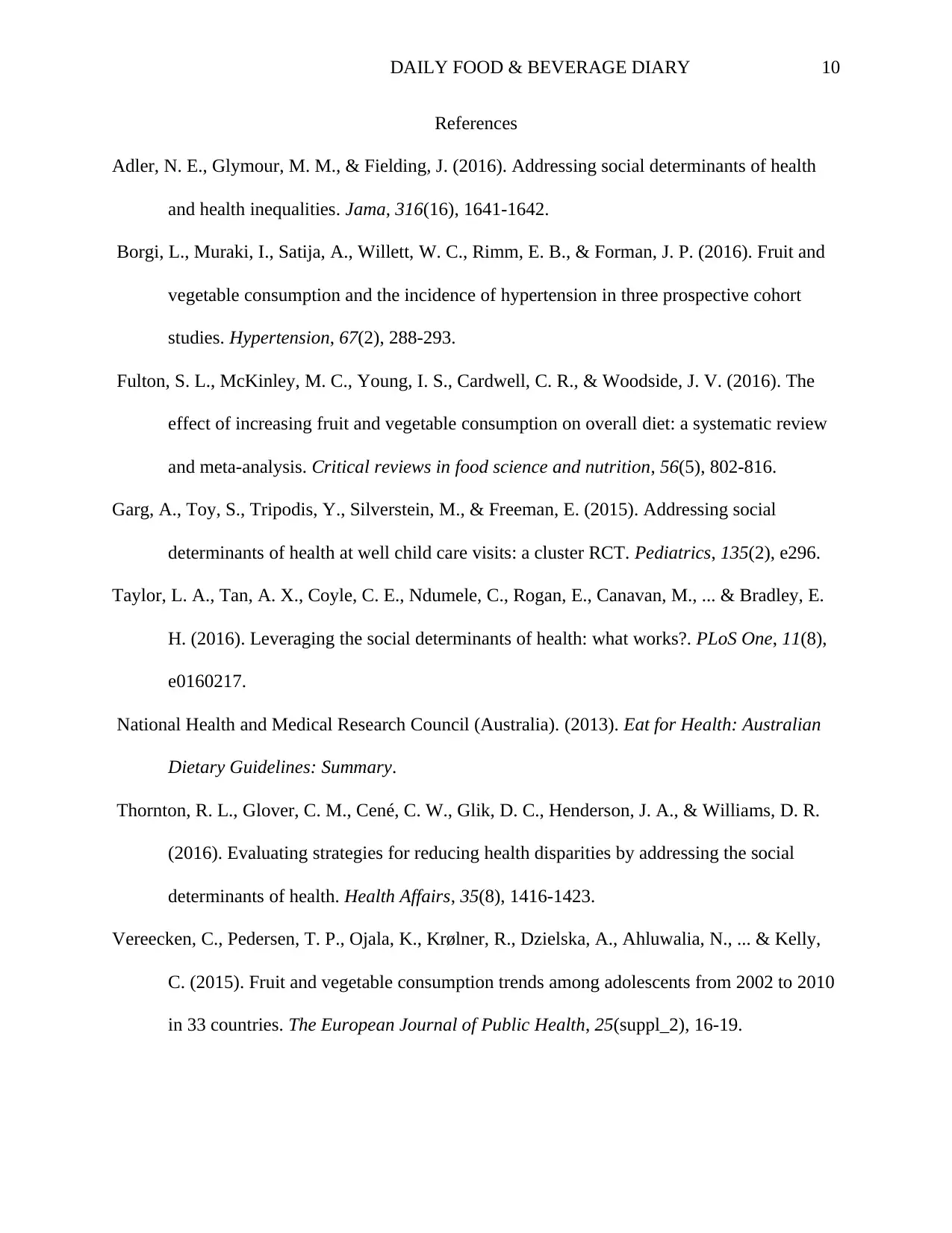
DAILY FOOD & BEVERAGE DIARY 10
References
Adler, N. E., Glymour, M. M., & Fielding, J. (2016). Addressing social determinants of health
and health inequalities. Jama, 316(16), 1641-1642.
Borgi, L., Muraki, I., Satija, A., Willett, W. C., Rimm, E. B., & Forman, J. P. (2016). Fruit and
vegetable consumption and the incidence of hypertension in three prospective cohort
studies. Hypertension, 67(2), 288-293.
Fulton, S. L., McKinley, M. C., Young, I. S., Cardwell, C. R., & Woodside, J. V. (2016). The
effect of increasing fruit and vegetable consumption on overall diet: a systematic review
and meta-analysis. Critical reviews in food science and nutrition, 56(5), 802-816.
Garg, A., Toy, S., Tripodis, Y., Silverstein, M., & Freeman, E. (2015). Addressing social
determinants of health at well child care visits: a cluster RCT. Pediatrics, 135(2), e296.
Taylor, L. A., Tan, A. X., Coyle, C. E., Ndumele, C., Rogan, E., Canavan, M., ... & Bradley, E.
H. (2016). Leveraging the social determinants of health: what works?. PLoS One, 11(8),
e0160217.
National Health and Medical Research Council (Australia). (2013). Eat for Health: Australian
Dietary Guidelines: Summary.
Thornton, R. L., Glover, C. M., Cené, C. W., Glik, D. C., Henderson, J. A., & Williams, D. R.
(2016). Evaluating strategies for reducing health disparities by addressing the social
determinants of health. Health Affairs, 35(8), 1416-1423.
Vereecken, C., Pedersen, T. P., Ojala, K., Krølner, R., Dzielska, A., Ahluwalia, N., ... & Kelly,
C. (2015). Fruit and vegetable consumption trends among adolescents from 2002 to 2010
in 33 countries. The European Journal of Public Health, 25(suppl_2), 16-19.
References
Adler, N. E., Glymour, M. M., & Fielding, J. (2016). Addressing social determinants of health
and health inequalities. Jama, 316(16), 1641-1642.
Borgi, L., Muraki, I., Satija, A., Willett, W. C., Rimm, E. B., & Forman, J. P. (2016). Fruit and
vegetable consumption and the incidence of hypertension in three prospective cohort
studies. Hypertension, 67(2), 288-293.
Fulton, S. L., McKinley, M. C., Young, I. S., Cardwell, C. R., & Woodside, J. V. (2016). The
effect of increasing fruit and vegetable consumption on overall diet: a systematic review
and meta-analysis. Critical reviews in food science and nutrition, 56(5), 802-816.
Garg, A., Toy, S., Tripodis, Y., Silverstein, M., & Freeman, E. (2015). Addressing social
determinants of health at well child care visits: a cluster RCT. Pediatrics, 135(2), e296.
Taylor, L. A., Tan, A. X., Coyle, C. E., Ndumele, C., Rogan, E., Canavan, M., ... & Bradley, E.
H. (2016). Leveraging the social determinants of health: what works?. PLoS One, 11(8),
e0160217.
National Health and Medical Research Council (Australia). (2013). Eat for Health: Australian
Dietary Guidelines: Summary.
Thornton, R. L., Glover, C. M., Cené, C. W., Glik, D. C., Henderson, J. A., & Williams, D. R.
(2016). Evaluating strategies for reducing health disparities by addressing the social
determinants of health. Health Affairs, 35(8), 1416-1423.
Vereecken, C., Pedersen, T. P., Ojala, K., Krølner, R., Dzielska, A., Ahluwalia, N., ... & Kelly,
C. (2015). Fruit and vegetable consumption trends among adolescents from 2002 to 2010
in 33 countries. The European Journal of Public Health, 25(suppl_2), 16-19.
1 out of 10
Related Documents
Your All-in-One AI-Powered Toolkit for Academic Success.
+13062052269
info@desklib.com
Available 24*7 on WhatsApp / Email
![[object Object]](/_next/static/media/star-bottom.7253800d.svg)
Unlock your academic potential
© 2024 | Zucol Services PVT LTD | All rights reserved.





